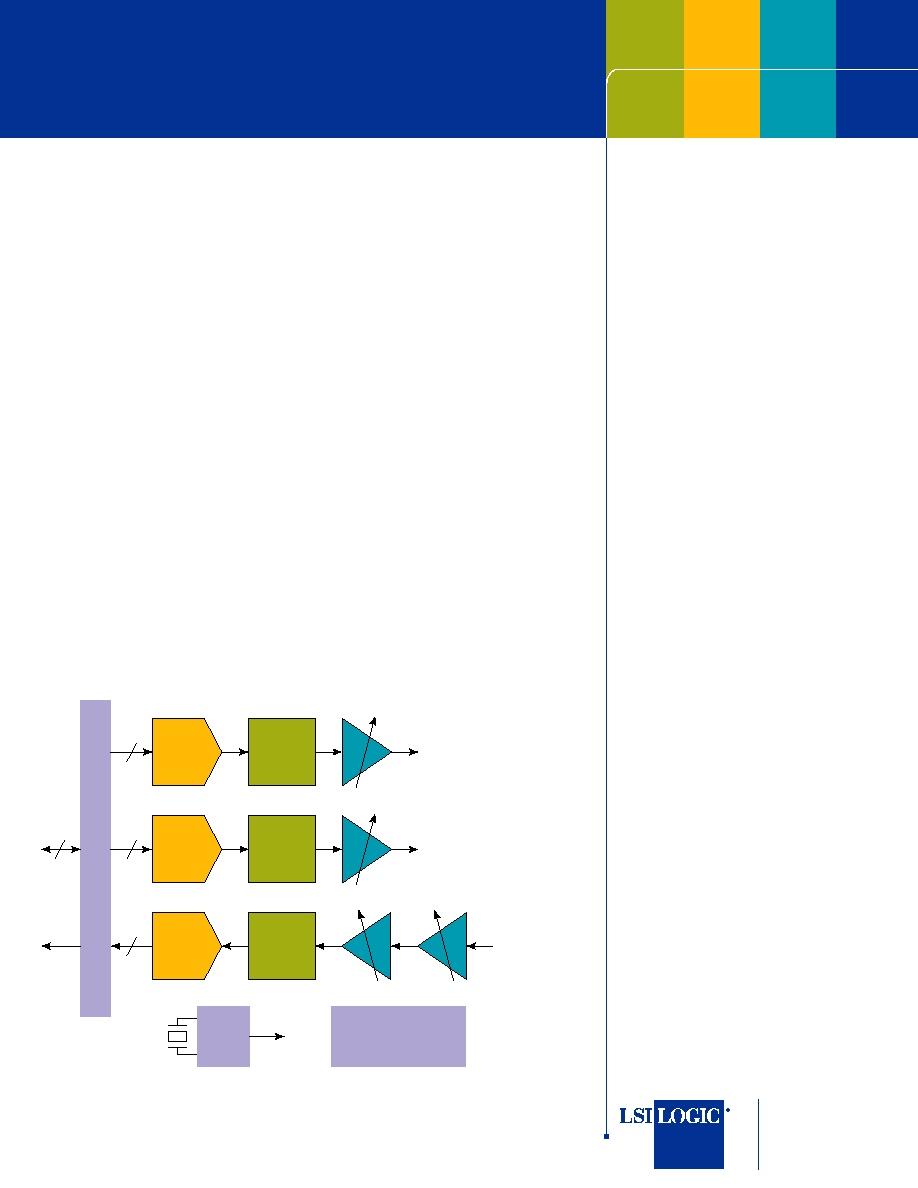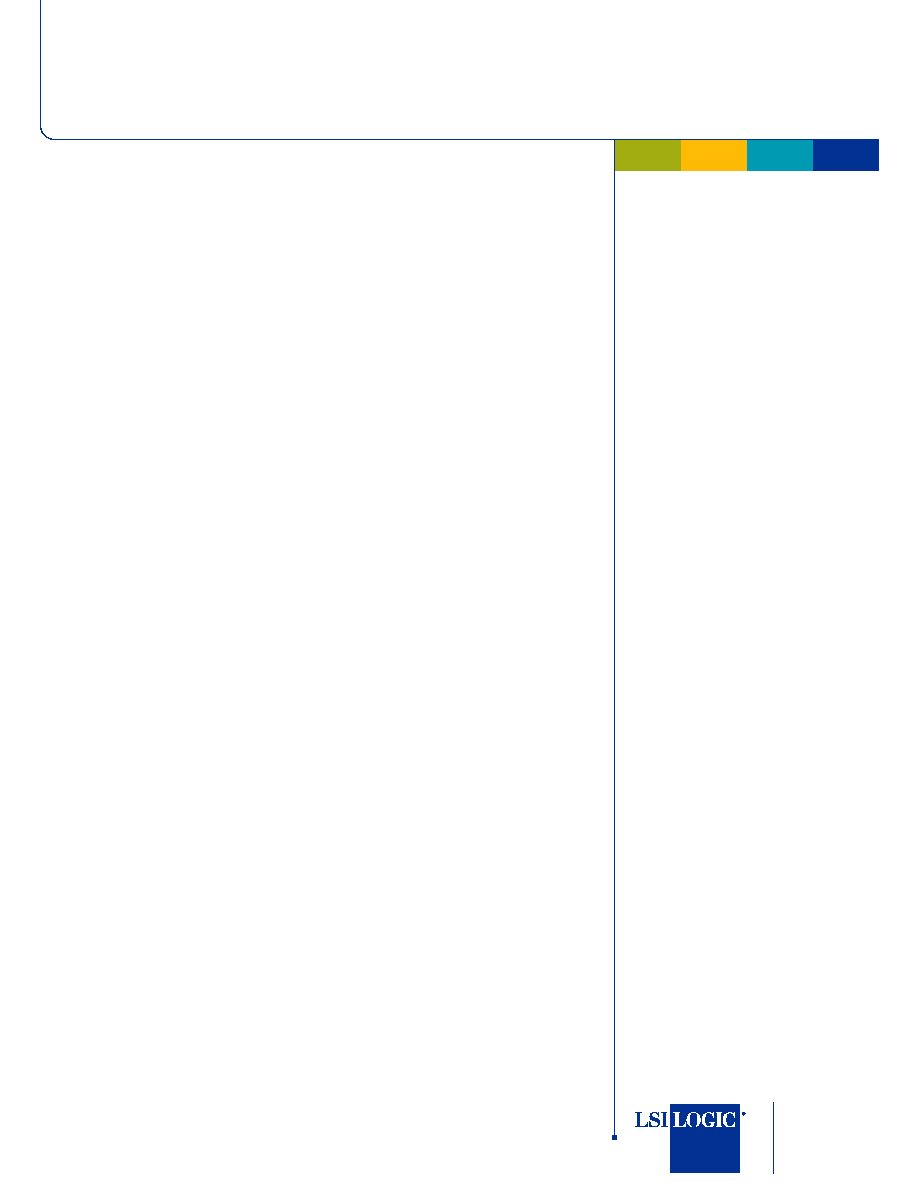
The
Communications
Company
TM
O V E R V I E W
Asymmetric digital subscriber line (ADSL) technology provides a viable solution
to meet the emerging need for high-bandwidth communications to the home while
utilizing existing twisted-pair copper infrastructure. LSI Logic's SpeedREACH
analog front ends (AFEs) meet this need by boosting the performance of customer
premise and central office equipment, creating new market opportunites for
OEMs. The SpeedREACH AR8201 is a highly integrated AFE designed to
perform all of the analog functions of the receive (RX) and transmit (TX) paths
for ADSL customer premise modems -- full-rate and G.lite. The AR8201 is also
the industry's first AFE to offer the integrated combination of a +5 V line driver
and digitally controlled crystal oscillator (DCXO), eliminating the need for a +12 V
supply required when using an external line driver.
The RX portion of the chip consists of a low-noise programmable gain
amplifier (PGA) having a gain range of -6 dB to +38 dB in 0.25 dB steps, an
anti-aliasing filter, and a 16-bit analog-to-digital converter (ADC). The TX
portion consists of a 16-bit digital-to-analog converter (DAC), a transmit low-
pass filter, and a programmable attenuation amplifier (PAA) with an attenuation
of 0 dB to -24 dB in 1 dB steps. To simplify the overall system design, DAC
droop compensation is handled internally, removing this burden from the back-
end signal processing.
SpeedREACH
TM
AR8201 -- ADSL AFE
for CPE with +5V Line Driver+DCXO
F E A T U R E S
∑ ADSL CPE AFE with full RX and TX
analog signal path
∑ Compatible with both ITU G.992.1 and
(G.dmt) and G.992.2 (G.lite) standards
∑ Integrated line driver capable of
driving +13 dBm onto the line using
a 4.25:1 transformer
∑ Low-power wakeup detector for G.hs
(G.994.1) and ANSI T1E1.413 Issue 7
wakeup protocol
∑ Programmable interface for RX/TX
digital data
∑ Integrated DCXO
∑ Power: 1W (driving +13 dBm DMT
signal onto the line)
∑ Line driver total harmonic distortion for
138 kHz sinewave at 7.4 V peak-to-peak
differential with either (a) 11
W resistance
load or (b) 5.5
W resistance and 4.25:1
transformer: -85 dB
∑ 14-bit linear 4.4 MS/s ADCs and
14-bit linear 4.4 MS/s DACs
∑ 4th-order low-pass filters for RX/TX paths
with a ±5% cutoff frequency accuracy
∑ TX channel: support for 138 kHz and
276 kHz (for ADSL over ISDN)
∑ RX channel: support for both 552 kHz
(G.lite) and 1.104 MHz (G.dmt)
∑ Entire RX channel linearity: 80 dB MTPR
and TX channel linearity: 80 dB MTPR
∑ RX input-referred noise at peak gain:
≠160 dBm/Hz at 300 kHz
DAC
4.4MHz
16
TX LPF
138kHz/
276kHz
DAC
4.4MHz
TX Out
16
PAA and Line Driver
TX LPF
138kHz/
276kHz
Support Blocks
VCXO DAC
G.hs wakeup detector
DCXO
D
I
G
I
T
A
L
I/F
16
TX/RX
Data
Echo Out
PAA
ADC
4.4MS/s /
2.2 MS/s
RX In
16
MCLK
35.328 MHz
Fine PGA
Low-Noise Coarse PGA
RX LPF
1.1MHz/
552kHz
STRB
Programmable to
Either 16-bit Parallel
or 4/2/1-bit
Nibble/Serial
Figure 1. Block diagram of the SpeedREACH AR8201.

The
Communications
Company
TM
SpeedREACH
TM
AR8201
This device includes an integrated TX line driver and, with an appropriate
4.25:1 step up transformer, can drive +13 dBm onto the twisted pair line, as
required for the upstream channel in both G.992.1 and G.992.2. Total harmonic
distortion of the entire TX channel including the driver is better than -80 dB at
full power (+13 dBm on the line).
Apart from the primary signal paths, the chip also contains support
circuitry for other functions required in an ADSL modem. To assist in timing
recovery, a 12-bit DAC is present to drive an off-chip voltage controlled crystal
oscillator (VCXO). An on-chip DCXO is also present, allowing the modem
manfacturer to replace an expensive external VCXO module with a low-cost
crystal. An all-analog "wakeup" detector is present when the ADSL line is
unused, all of the back-end digital and analog circuitry in the modem can thus
be powered down, facilitating significant power savings.
A 4-wire serial port provides a simple DSP interface. The serial port is used
to modify internal register values, which in turn control attenuation/gain settings,
filter bandwidths and the power down of individual blocks. The chip is powered
off a +5 V supply while all digital I/Os run off a +3.3 V supply. The AR8201
is available in a 100-pin LQFP plastic package. The operating temperature
range is between -40∞C and +85∞C.
For more information please call:
LSI Logic Corporation
North American Headquarters
Milpitas, CA
Tel: 800 574 4286
LSI Logic Europe Ltd.
European Headquarters
United Kingdom
Tel: 44 1344 426544
Fax: 44 1344 481039
LSI Logic KK Headquarters
Tokyo, Japan
Tel: 81 3 5463 7165
Fax 81 3 5463 7820
LSI Logic web site
www.lsilogic.com
LSI Logic logo design, is a registered trademark
and SpeedREACH is a trademark of LSI Logic
Corporation. All other brand and product names
may be trademarks of their respective companies.
LSI Logic Corporation reserves the right to make
changes to any products and services herein at any
time without notice. LSI Logic does not assume any
responsibility or liability arising out of the
application or use of any product or service
described herein, except as expressly agreed to in
writing by LSI Logic; nor does the purchase, lease,
or use of a product or service from LSI Logic
convey a license under any patent rights,
copyrights, trademark rights, or any other of the
intellectual property rights of LSI Logic or of third
parties.
Copyright ©2001 by LSI Logic Corporation.
All rights reserved.
Order No. R20028
101.1k.JG.TP - Printed in USA

